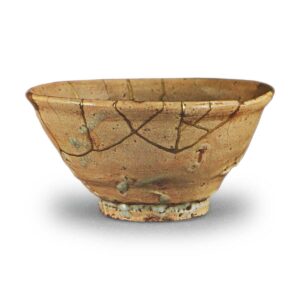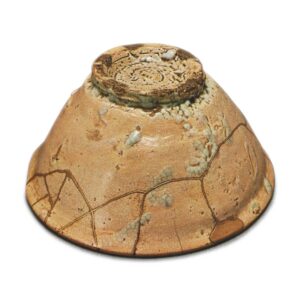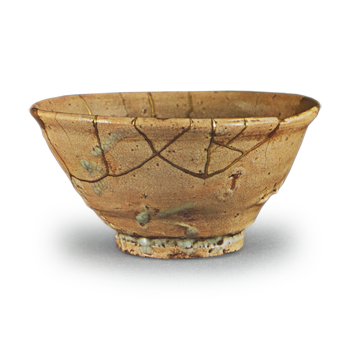

Meibutsu
Height: 6.5cm
Diameter: 12.7-13.4cm
Outer diameter of foot ring: 5.6cm
Height of foot ring: 0.9-1.0cm
The name “Nagasaki” is derived from the fact that it was once owned by Nagasaki Kyudayu Shosai, a doctor from Kyoto, and although it is in a very poor condition, it is still considered to be one of the best bowls in the world. Ichimasa was known as a tea ceremony enthusiast at the time, and other bowls associated with his ownership include Nagasaki Kente, Nagasaki Kumagawa, Nagasaki Tenmoku, and Nagasaki Tsutsumi (Seto).
Ido-waki means “well-side”, or “well-like”, and in the “Famous Tea Utensil Appraiser’s Book” it says, “Ido-waki is similar to a well, but it is not as good as a well. There are many different types, some of which are quite plain, and the wood is noisier than a well. Although it is said that the quality of well-style tea utensils is lower than that of genuine tea utensils, and that this indicates the decline of the times, the phrase “the later period is called well-style” in the “Book of Tea Utensil Appreciation” is a phrase that directly expresses the true nature of the tea utensils.
Even though it is called “Ido-waki”, it is promised that it will have a clay-like appearance (glazed all over) and a visible mark on the inside, but it is generally thin and hard, with a smooth glaze, and the clay has less iron than Hon-te, so at first it was confused with Ko-ido, but later, as the distinction between the two became more refined, the difference between the two gradually became clear. As expected, the softness of the finish is highly prized. The distinguishing feature of Ido-waki is that, while it is made in the Ido style, it is not as good as the real thing. If you look closely, you will see that the clay and glaze are actually quite varied, and it is a little difficult to see them as a single style, but they are mostly thought to be from South Korea. At times, they are highly technical, and there are also pieces with a strong tea-ceremony feel, as well as pieces in the Dan and Gohon styles.
Nagasaki ware has a glossy, loquat-colored glaze, but in terms of shape, the rim is slightly turned up at the edge, and the foot is large and has a bamboo-joint shape, so it is inevitable that it is a little inferior to Hon-te. In terms of style, it is thought to be by the side of Ido, but the glaze is almost the same as that of Honte, and it can be called one of the best pieces by the side of Ido.
In particular, despite the repairs to the large cracks, the reason for its high reputation since ancient times is largely due to the mysterious charm of the glaze and other aspects. On the exterior, there are many changes in the glaze, such as glaze flows and glaze pools, from the rim to the body, and it has a bluish-white appearance like karagami (Japanese paper made from mulberry bark), with some areas of fire marks, adding a random appearance. From the side of the foot ring to the bamboo-joint foot ring, the rough karagami is magnificent. The tatami mat has five trays. The discrepancy in the rim at one point is also a major highlight. On the inside, the tea pool forms a spiral shape, and there are five eye marks in the glaze pool, with rough cracks of irregular size, three of which are attached to one place and mixed with rough cracks, etc., and it is rare to see such a natural wonder and endless tea charm.
Box, inside of lid, inscribed by Nagasaki Shosai: “This is a treasure of pottery, and it is a piece that resembles a well-known piece. It is a piece that has been repaired, and there are eight pieces that are clearly damaged. It is a piece that is particularly rare.
From the inscription on the box, we can see that even at the time when it was in the possession of Shosai, it was already in a very bad state, with a large tear in one of the eight pieces, but he still repaired it and treasured it, and he even inscribed it with the name “Hasshoki”, which shows the seriousness of Shosai as a tea ceremony enthusiast. Katamochi is a Hachimantai specialty old Koryo tea bowl owned by Shokado, and like the Nagasaki tea bowl, it appears that one side was also badly damaged.
It was passed down from Shosai’s possession to the Hirase family in Kyoto, and from there it was passed down to the family for a long time, but in recent years it has entered the possession of a certain family in Osaka.



